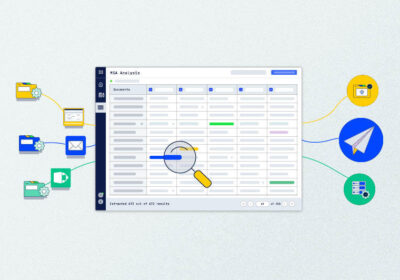LIBOR is Going Away. Do You Know Your Contract Exposure?
Goodbye. Adieu. Auf wiedersehen. After more than 30 years, that global benchmark rate for overnight lending, LIBOR, will be phased out by the end of 2021. It still remains to be seen what exactly will replace LIBOR (more about that later), but in the meantime there’s lots of crucial work to be done.
Any contract that employs LIBOR as a benchmark for floating rate loans will put the relevant parties at major economic risk. If you’re a bank, insurance company, pension fund, asset manager—really, any firm involved in the financial services ecosystem—you need to take action ASAP. With 2021 just around the corner, you need to know what’s in your contracts to make this transition smoothly and avoid severe financial loss.
In his recent remarks, Randal Quarles, the Federal Reserve’s vice chairman for banking supervision, cautioned “…beginning that transition now would be consistent with prudent risk management and the duty that you owe to your shareholders and clients.”
The impact of the LIBOR phase-out will be profound, but it doesn’t have to be paralyzing. With a well thought out roadmap, financial institutions can identify affected contracts, assess exposure, and define a mitigation strategy. Once this groundwork is laid, institutions are equipped to seamlessly remediate and repaper contracts, contain risk and operate with peace of mind.
Preparing for the LIBOR phase-out
In preparation for LIBOR’s replacement, financial institutions should create multi-workstream programs to understand which products will be affected, along with corresponding documents and contracts. It’s a massive undertaking, with an estimated total capital risk of $250-$350 trillion U.S.
Financial instruments that may be impacted by the LIBOR phase-out include:
- OTC and exchanged traded derivatives
- Syndicated loans
- Corporate loans
- Floating rate mortgages
- Corporate bonds
- Government bonds
Once you identify affected products, the next step is to find all associated contracts. Here is just a small sampling of what you’ll need to sift through:
- Investment management agreements
- Prime brokerage margin lending agreements
- Global master securities lending agreements
- Eligible master securities lending agreements
Financial service document repositories are notoriously complex, filled with thousands—or even tens of thousands—of documents. Diving in to locate impacted agreements will be like finding a needle, amidst a swirling tornado. You won’t be guided by a tidy folder, nor do you likely have tools in your arsenal all ready to aid you in your search.
Ask the right questions
To get a full picture of your financial exposure, here are a few of the most pressing questions:
● Is interest on any loans based on LIBOR?
● Is there a LIBOR floor?
● Is the contract active past 2021?
● Does the replacement of Screen Rate clause permit LIBOR to be replaced by Majority Lender consent?
● What is the definition of Majority Lender?
The result will be a hefty compilation. Imagine hundreds, even thousands, of agreements, each several hundred pages long. How do you prioritize? What’s urgent to remedy—and where do you have a little more time?
The answer lies in running these contracts through a prioritization funnel—another gargantuan and complex undertaking. Dates are of course a critical qualifier, but after that, what should be next on your priority list? And how do you make sure you don’t miss anything? It takes keen knowledge of financial products, financial and legal language, and how contracts are structured. It’s beyond the capabilities of manual intervention. There’s simply not enough time and skilled manpower.
Technology is the solution. Using natural language processing (NLP) to ask these questions, the identification and prioritization process can be automated. Quantitative and qualitative data points can be extracted. Risk can be mitigated.
What’s at risk? Money, reputation, relationships
There are two options for dealing with the replacement of LIBOR:
- Passive—letting contracts expire on their own
- Active—updating and replacing contracts
If your company takes the passive route, be forewarned: the financial exposure can be enormous. Floating rates are set every day; for contracts pegged to LIBOR, the absence of a newly calculated floating rate generally triggers a fall-back provision—conceived as a temporary stop-gap measure, and not intended to be used for more than a few days. This fall-back rate could be from “last month.” But as that fall-back date recedes into the past, you’ll find that the corresponding rate no longer reflects the current lending market.
The results will be swift and potent: for contracts with months (or possibly years) remaining after the LIBOR phase-out, floating rate loans will turn into de facto fixed rate loans. Contract holders will see real-time rates vary by several basis points[1] from the LIBOR fall-back rate. Some firms will make a windfall; others will lose their shirts: it all depends on the direction of the real-time rate, and which side of the deal you’re on. Playing the passive card is a gamble: since no one has a crystal ball, being passive exacerbates your financial risk.
What’s more, if all does not go in your favor, you expose yourself to a communications maelstrom. From home mortgage holders to interest-rate swap counter-parties, stakeholders will be asking about their rate—and the questions and the uncertainty will fly.
Create a workflow plan, now
The alternative to this vision of loss? You can actively update, replace, or wind down your affected contracts. This proactive stance caps and minimizes risk by putting in place an alternative benchmark rate, such as the Secured Overnight Financing Rate (SOFR).
Once banks think through their benchmark rate alternatives, they can update their risk models, repaper contracts and amendments, and also create new products. With this momentous change in the overnight lending rate, the overriding concern is “What is my future revenue?”
On the flip side, your accounting department wants to know your firm’s expense exposure. The cost to change contracts, update computer systems, and produce client communications can quickly spiral.
A detailed roadmap can help to ensure all documents are identified, risk is properly assessed, proactive response is taken, and costs are contained. But the need to act is now. 2021 will be here before you know it.
Eigen is embedded in the front, middle, and back office to automate the workstreams at some of the world’s most respected financial institutions. With our deep understanding of the complexities of risk management and natural language processing (NLP) technology, our solution works with the full spectrum of documents, across all banking operations. With the LIBOR phase-out, Eigen is here to provide clarity, minimize risk, and reduce costs for your financial institution.
-
World Economic forum 2020
-
Gartner Cool Vendor 2020
-
AI 100 2021
-
Lazard T100
-
FT Intelligent Business 2019
-
FT Intelligent Business 2020
-
CogX Awards 2019
-
CogX Awards 2021
-
Ai BreakThrough Award 2022
-
CogX Awards Best AI Product in Insurance
-
FStech 2023 awards shortlisted
-
ISO27001
-
ISO22301
-
ISO27701
-
ISO27017
-
ISO27018


















